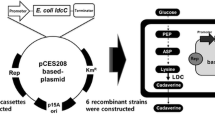Abstract
Temperature shift cultivations with amino acid supplementation were optimized to produce porcine adenylate kinase (ADK) in recombinant Escherichia coli harboring a pUC-based recombinant plasmid under the control of the trp promoter. With regard to temperature control, the culture condition was initially maintained at 35 °C for cellular growth, but ADK expression was suppressed until the late logarithmic growth phase; subsequently, a temperature shift was applied (from 35 °C to 42 °C), which resulted in maximal ADK production. In addition, supplementation of amino acids, especially valine and leucine, during the temperature shift stimulated ADK expression from 3.5% to 9.2% and 8.6% of the total protein, respectively. After optimization, 1 g ADK per liter was produced within 16 h of cultivation with a dry cell weight of 21.8 g/l. In this system, there was no loss of the recombinant plasmid during cultivation without selective pressure.

Similar content being viewed by others
References
Yildirim, S., Konrad, D., Calvez, S., Drider, D., Prevost, H., & Lacroix, C. (2007). Production of recombinant bacteriocin divercin V41 by high cell density Escherichia coli batch and fed-batch cultures. Applied Microbiology and Biotechnology, 77, 525–531.
Tabandeh, F., Shojaosadati, S. A., Zomorodipour, A., Khodabandeh, M., Sanati, M. H., & Yakhchali, B. (2004). Heat-induced production of human growth hormone by high cell density cultivation of recombinant Escherichia coli. Biotechnology Letters, 26, 245–250.
Schmidt, M., Viaplana, E., Hoffmann, F., Marten, S., Villaverde, A., & Rinas, U. (1999). Secretion-dependent proteolysis of heterologous protein by recombinant Escherichia coli is connected to an increased activity of the energy-generating dissimilatory pathway. Biotechnology and Bioengineering, 66, 61–67.
Frey, K. M., Oppermann-Sanio, F. B., Schmidt, H., & Steinbuchel, A. (2002). Technical-scale production of cyanophycin with recombinant strains of Escherichia coli. Applied and Environmental Microbiology, 68, 3377–3384.
Kim, D. M., & Swartz, J. R. (2001). Regeneration of adenosine triphosphate from glycolytic intermediates for cell-free protein synthesis. Biotechnology and Bioengineering, 74, 309–316.
Matsui, T., Sato, H., Yamamuro, H., Shinzato, N., Matsuda, H., Misawa, S., et al. (2008). High cell density cultivation of recombinant E. coli for hirudin variant 1 production by temperature shift controlled by pUC18-based replicative origin. Applied Microbiology and Biotechnology, 80, 779–783.
Hibino, T., Misawa, S., Wakiyama, M., Maeda, S., Yazaki, K., Kumagai, I., et al. (1994). High-level expression of porcine muscle adenylate kinase in Escherichia coli: Effects of the copy number of the gene and the translational initiation signals. Journal of Biotechnology, 32, 139–148.
Matsui, T., Yokota, H., Sato, S., Mukataka, S., & Takahashi, J. (1989). Pressurized culture of Escherichia coli for a high concentration. Agriculture and Biological Chemistry, 53, 2115–2120.
Matsui, T., Shinzato, N., Haruto, Y., Takahashi, J., & Sato, S. (2006). High cell density cultivation of recombinant E. coli with a pressurized culture. Process Biochemistry, 41, 920–924.
Matsui, T., Sato, H., Yamamuro, H., Misawa, S., Shinzato, N., Matsuda, H., et al. (2008). High cell density cultivation of recombinant Escherichia coli for hirudin variant 1 production. Journal of Biotechnology, 134, 88–92.
Sambrook, J., Fritsch, E. F., & Maniatis, T. (1989). Molecular cloning: A laboratory manual. Cold Spring Harbor: Cold Spring Harbor Laboratory.
Bradford, M. M. (1976). A rapid and sensitive method for the quantitation of microgram quantities of protein utilizing the principle of protein-dye binding. Analytical Biochemistry, 72, 248–254.
Ansorge, M. B., & Kula, M. R. (2000). Production of recombinant l-leucine dehydrogenase from Bacillus cereus in pilot scale using the runaway replication system E. coli[pIET98]. Biotechnology and Bioengineering, 68, 557–562.
Winter, J., Neubauer, P., Glockshuber, R., & Rudolph, R. (2001). Increased production of human proinsulin in the periplasmic space of Escherichia coli by fusion to DsbA. Journal of Biotechnology, 84, 175–185.
Phue, J. N., & Shiloach, J. (2004). Transcription levels of key metabolic genes are the cause for different glucose utilization pathways in E. coli B (BL21) and E. coli K (JM109). Journal of Biotechnology, 109, 21–30.
Peng, L., & Shimizu, K. (2003). Global metabolic regulation analysis for Escherichia coli K12 based on protein expression by 2-dimensional electrophoresis and enzyme activity measurement. Applied Microbiology and Biotechnology, 61, 163–178.
Chang, L. L., Hwang, L. Y., Hwang, C. F., & Mou, D. G. (1991). Study of high density Escherichia coli fermentation for production of porcine somatotropin protein. Annals of the New York Academy of Sciences, 646, 259–272.
Kavanagh, J. M., & Barton, G. W. (2008). Productivity improvement of recombinant Escherichia coli fermentation via robust optimization. Bioprocess and Biosystems Engineering, 31, 137–143.
Misawa, S., & Kumagai, I. (1999). Refolding of therapeutic proteins produced in Escherichia coli as inclusion bodies. Biopolymers, 51, 297–307.
Author information
Authors and Affiliations
Corresponding author
Rights and permissions
About this article
Cite this article
Matsui, T., Togari, T., Misawa, S. et al. Optimized Culture Conditions for the Efficient Production of Porcine Adenylate Kinase in Recombinant Escherichia coli . Appl Biochem Biotechnol 162, 823–829 (2010). https://doi.org/10.1007/s12010-010-8913-4
Received:
Accepted:
Published:
Issue Date:
DOI: https://doi.org/10.1007/s12010-010-8913-4




